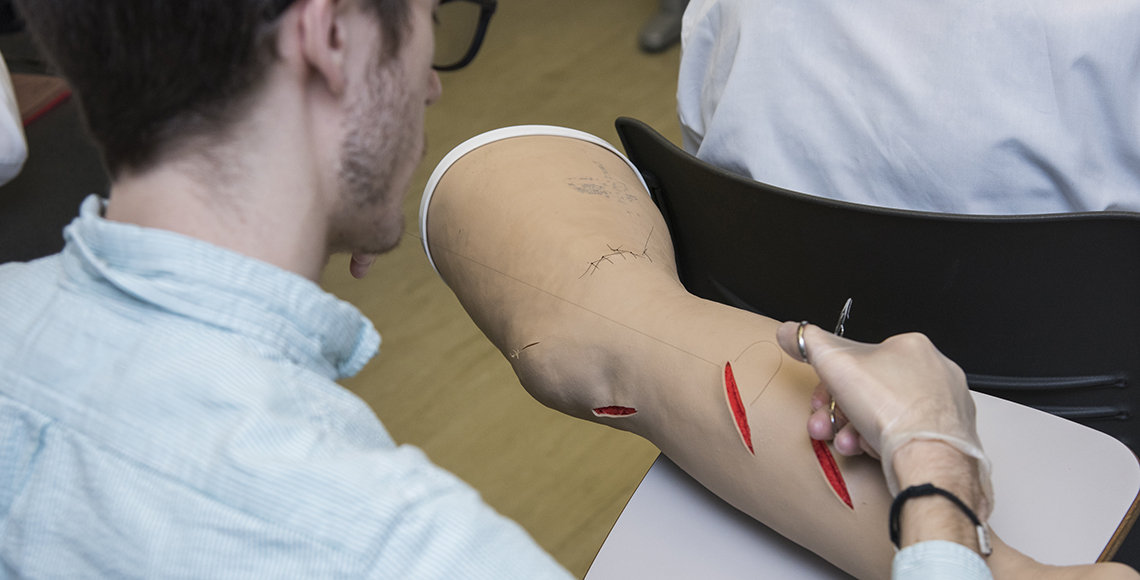A frail patient in the intensive care unit is gasping for air and codes. The attending physician is minutes away from the bedside, but the patient needs help now. Although licensed nurse practitioners in South Carolina are allowed to perform life-saving procedures such as intubation, in many care settings across the state, they do not.
The University of South Carolina’s College of Nursing aims to change that norm by equipping students in the adult gerontology acute care nurse practitioner program with the knowledge, confidence and skills to practice at the top of their license. As part of that effort, program director Amy Dievendorf launched an innovative two-day on-campus skills immersion training session to better prepare graduates to play a larger role on the health care team and be more marketable to potential employers. Having nurse practitioners take on a heavier procedure load can improve patient care, and for some patients in small rural facilities, may eliminate the need to be transferred to a larger facility, she says.
“I want to teach my students everything they can do so they will practice to their full scope when they graduate and be better trained providers for their patients.”
Dr. Amy Dievendorf, AGACNP Program Director
With a grant from the Helen-Gurley Wolford fund, Dievendorf collaborated with simulation lab director Crystal Graham to design a day-long series of stations where groups of five or six students could observe and practice skills including splinting and casting, suturing, vascular line placement, chest tube insertion and intubation. Clinical faculty members helped to recruit colleagues from across the region who served as experts for each skill station, providing an overview and demonstration of the skill as well as sharing practical tips and critiquing the 31 students as they practiced. On the second day, small groups of students completed ultrasound training and went through a capstone simulation exercise to practice their decision-making and clinical skills.
At the intubation station, Melinda Long, CRNA, reviews patient positioning and explains the differences between intubation blade types and sizes. “You probably just broke that tooth,” she says as a student struggles on her first try to intubate the manikin. “Remember the motion is up and out. If a patient has dentures, take them out. If there’s a dangling tooth because of trauma, pull it.”
In casting, Patrick Todd (BSN '06, MSN '12) , demonstrates how to immobilize the ankle and helps students find the best water temperature to activate the plaster but cool enough to prevent patient burns. “Keep the ankle up,” he coaches a student as she begins wrapping the leg of her patient, a fellow student. “Make sure you bend the knee." Todd, who works in the emergency department at Prisma Health Richland Hospital, also says it’s important to review post-discharge care instructions with patients. His top tip? “If a patient’s leg is itchy, tell them to put a hair dryer on a cool setting and blow dry the cast for a few minutes.”
Laura McDowell, a critical care nurse at Atrium Health in Charlotte, NC, says she had previously practiced some of the skills with her preceptor but says the training was helpful because of the low-stress learning environment. “It just felt safe,” she says. “It wasn’t like trying the first time on a person and having to worry about the possibility if anything goes wrong. I was surprised by the type of manikins the college has and how true they looked to real-life anatomy.”
Annie Blakeman, a nurse from Fort Mill, SC, says she had never performed most of the skills that were reviewed at the training. She says she understood the steps for each procedure from class lectures and reading but says the opportunity to have hands-on practice with each skill was invaluable. “Feeling the pressure, knowing how much resistance you should feel, that sort of knowledge can’t be taught in a book,” she says.
Dievendorf surveyed students before and after the training to measure whether the training increased their confidence in their ability to perform the skills, and she will study the results to improve future training sessions and inform nurse practitioner education practices. Although medical students receive extensive hands-on training on procedures, Dievendorf says few similar opportunities are available for advanced practice nurses, and the professional literature about such nurse training is very limited.
